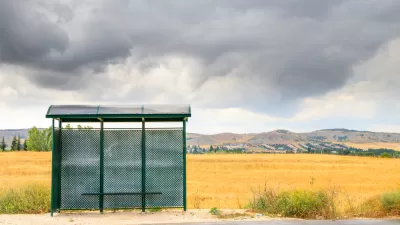Parts of California’s rural, working-class Central Valley see virtually no transportation investment, leaving many residents stranded in the heat.

KCET and local youth media group Coachella Unincorporated explore conditions in a rural desert community in Southern California, where some areas have only one, infrequent bus route.
Although local transportation agencies cite low ridership as a driver of scant service, community groups note that ridership has risen on occasions when service has increased.
Community and faith-based groups advocating for transportation equity in the area describe to reporters the conditions residents struggle through to get around—walking and waiting for hours in the desert heat.
There is some state interest in investing in rural disadvantaged communities. But with constrained transportation funding, when climate goals encourage transit projects in dense urban areas, that interest can face an uphill battle.
Eduardo Garcia (D-Coachella), who is pushing to expand transit service and create first-mile connections in the Coachella Valley, is quoted as saying:
"Some people had concerns about the bill because [they believed] we are doing too much for disadvantaged communities… For some people, that was a concern because it was taking away from the traditional funding course.”
FULL STORY: Miles Away from the Next Stop: The Bumpy Road to Transportation Equity

Study: Maui’s Plan to Convert Vacation Rentals to Long-Term Housing Could Cause Nearly $1 Billion Economic Loss
The plan would reduce visitor accommodation by 25,% resulting in 1,900 jobs lost.

North Texas Transit Leaders Tout Benefits of TOD for Growing Region
At a summit focused on transit-oriented development, policymakers discussed how North Texas’ expanded light rail system can serve as a tool for economic growth.

Why Should We Subsidize Public Transportation?
Many public transit agencies face financial stress due to rising costs, declining fare revenue, and declining subsidies. Transit advocates must provide a strong business case for increasing public transit funding.

How to Make US Trains Faster
Changes to boarding platforms and a switch to electric trains could improve U.S. passenger rail service without the added cost of high-speed rail.

Columbia’s Revitalized ‘Loop’ Is a Hub for Local Entrepreneurs
A focus on small businesses is helping a commercial corridor in Columbia, Missouri thrive.

Invasive Insect Threatens Minnesota’s Ash Forests
The Emerald Ash Borer is a rapidly spreading invasive pest threatening Minnesota’s ash trees, and homeowners are encouraged to plant diverse replacement species, avoid moving ash firewood, and monitor for signs of infestation.
Urban Design for Planners 1: Software Tools
This six-course series explores essential urban design concepts using open source software and equips planners with the tools they need to participate fully in the urban design process.
Planning for Universal Design
Learn the tools for implementing Universal Design in planning regulations.
Ascent Environmental
Borough of Carlisle
Institute for Housing and Urban Development Studies (IHS)
City of Grandview
Harvard GSD Executive Education
Toledo-Lucas County Plan Commissions
Salt Lake City
NYU Wagner Graduate School of Public Service





























